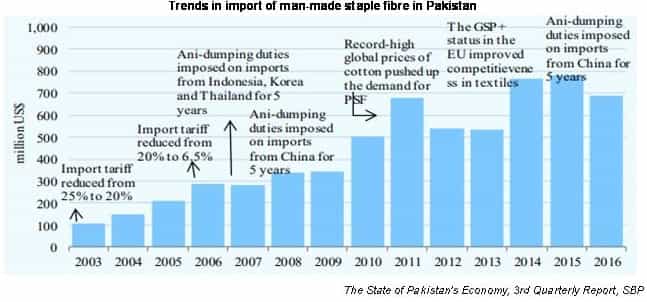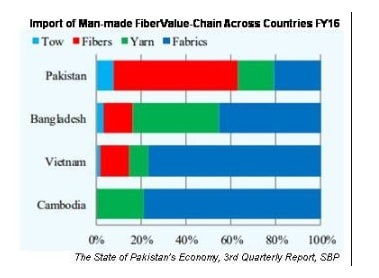Textiles paying polyester protection textile industry - Arhive
Textiles: paying for polyester protection Textiles paying polyester protection textile industry
Adaptability holds paramount importance in today’s continuously evolving consumer landscape. After all, the customer knows best and any production incompatible with those wishes will simply fail to make its mark.

While the textile industry has faced a lot of problems including a high cost of production and an overvalued currency, the lack of product diversification is one that has made Pakistan’s products out-dated and at the risk of becoming irrelevant in the modern space.
Much has been written about it in this space (Read: Changing trends in textiles and Textile: Evolving consumer preferences) and the State Bank of Pakistan’s (SBP) recently released third quarterly report has a special section dedicated to the importance of synthetic textiles for sustaining export growth momentum.

Pakistan continues to have a pre-dominantly cotton based textile industry while the share of cotton in global fibre consumption has sharply declined from 70 percent more than fifty years ago to 27 percent in 2016.Textiles paying polyester protection textile industry
The country’s fibre mix is still 80:20 in favour of cotton while according to the report only 25 percent of Pakistan’s spinning machines are using man-made fibres (MMF) to produce blended yarn.Textiles paying polyester protection textile industry
On the other hand, our neighbours China, India and Bangladesh and other Asian countries including Vietnam and Cambodia together account for more than 80 percent of global polyester staple fibre (PSF) and have become the major players in synthetic textile exports.
Granted, Pakistan does not have an established chemical industry to aid in the production of textile polymers. But as the central bank points out, Vietnam, Bangladesh and Cambodia import MMFs fibres, yarns and fabrics to produce and export synthetic garments. In fact Vietnam is the second biggest exporter of synthetic textile to the US after China.Textiles paying polyester protection textile industry
So why has Pakistan been left so far behind the curve? The answer lies in illogical policies pertaining to duty imposition (Read: Illogical protectionist measures) leading to what the SBP correctly terms as anti-export bias.
Both purified terephthalic acid (PTA) and PSF have enjoyed high duty protection with a 25 percent duty imposed way back in late nineties.Textiles paying polyester protection textile industry
After this the share of MMFs in Pakistan’s textile product mix steadily declined even though the duty structure has been somewhat relaxed since then.
Moreover, as the central bank points out the tariff liberalisation has not been uniformly applied to finished products which have more protection compared to raw materials including tow and fibres.Textiles paying polyester protection textile industry
What this has done is tilt Pakistan’s imports towards fibres in stark contrast to regional peers including Vietnam and Cambodia who import full spectrum of synthetic textiles as illustrated by the figure.Textiles paying polyester protection textile industry
But even fibres are being subject to high tariff rates as compared to regional peers supposedly to provide protection to the domestic polyester industry.
The government has kept the customs duty at 7 percent in favour of local manufacturers while exporters are paying 11 percent customs duty, as well as 5 percent regulatory duty, on the import of filament yarn.
But at what cost? According to the National Tariff Commission’s (NTC) determination of anti-dumping duty on PSF, the lion’s share of the production is held by Ibrahim Fibers Limited (55%) and ICI Pakistan Limited (29%). Production by both companies for FY17 clocked in at 290,697 and 121,929 tons respectively. But industry stakeholders argue this production only meets a small part of overall fiber consumption in the country.
The Pakistan Yarn Merchants Association (PYMA) believes that for polyester FDY yarn (HS. Code 5402.4700) the local production amounts to only 3 percent and the remaining is imported. Similarly, polyester DTY’s (HS Code 5402.3300) local production amounts to only 25 percent of the required needs of the weaving industry whereas the rest again needs to be imported. This raises some important questions. Firstly if the local supply is unable to meet the required demand what is the purpose imposing an anti-dumping duty? Secondly, as the SBP pertinently points out if after adding all these duties and tariff barriers what is the point if the domestic industry fails to flourish?
As this newspaper has commented before and the SBP has reiterated in its report, the government should reconsider protectionist policies for polyester fibre and filaments if Pakistan’s textile sector is to catch up in the race of shifting towards synthetic fibres.
Related Topics
